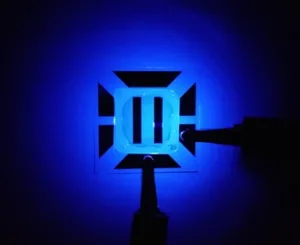A team of researchers has developed a new blue light-emitting phosphorescent OLED (PHOLED) molecule, which is close to meeting the brightness requirements of the USA’s National Television Systems Committee (NTSC).
Stephen Forrest is from the University of Michigan (UoM), which worked on the project with the University of Southern California (USC). He said “Bright, deep blue, phosphorescent emitters have been very elusive. Our work has resulted in deep, display quality blue at very high efficiency and extremely high brightness”.
PHOLEDs have the potential to use as little as 25% of the energy required by today’s fluorescent OLEDs. However, blue PHOLEDs have not yet been created that reach the necessary brightness and richness of colour. Green and red PHOLEDs are being used today by Samsung and LG, but the blue in their displays is still from a fluorescent OLED, says the UoM.
The new molecule is an iridium complex; specifically a type known as an N-heterocyclic carbene iridium-III complex. The ‘exceptional’ brightness (around 10 times that of similar PHOLEDs) is partly due to the way that the team used the molecule: it acts as the light emitter, while also conducting positive charges into the light-emitting layer and keeping the negatively-charged electronics from leaving it. This prevents wasted electricity. The combination of electronics and positively-charged ‘holes’ (which releases energy in the form of light) takes place in the iridium complexes, producing a deep blue light.
Jaesang Lee, a graduate student at UoM, built the PHOLED. It is layered, with the central layer – a mix of host organic semiconductor and iridium complex – emitting light. This layer is sandwiched between hole- and electron-blocking (the iridium complex) layers. This prevents holes and electrons from leaving the light-emitting portion, and means that the PHOLED shines brightly at high electrical currents.
“Since the holes travel through the electron-blocking layer, which is made of the same iridium complex as the light emitters, there is no energy loss when the holes enter the light-emitting layer”, said Lee. “As a result, the device is more efficient”.
However, when too many energetic electrons and holes are concentrated in one place – usually near the electron-conducting layer – they can break apart the light-emitting molecules. To counteract this, Lee built the light-emitting portion with fewer iridium complexes near the electron-conducting layer. This has the effect of drawing electrons deeper into the light-emitting section.
The work was published in the journal Nature Materials: http://tinyurl.com/q7wn3vf. The UoM has licensed the concept to Universal Display Corporation.
Analyst Comment
This is big news from a technology point of view. Weak blues (in wavelength, efficiency and lifetimes) have been the achilles heel of OLEDs since the technology was first developed. The development of phosphorescent materials was an essential part of turning OLEDs into commercial products, but the blue has remained the problem with additional complication needed to achieve acceptable results. It’s not clear, yet, what issues there might be in bringing this architecture to market, but it will do UDC no harm! (BR)

